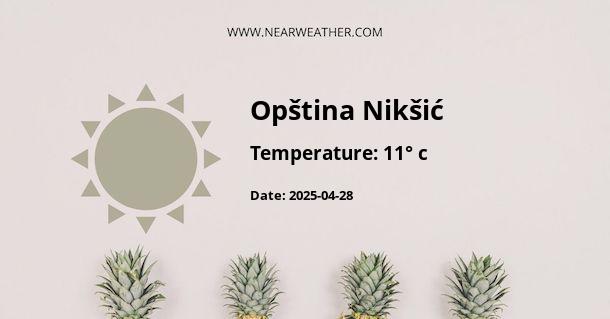Climate and Weather Overview of Opština Nikšić, Montenegro
Opština Nikšić, located in the western part of Montenegro, is known for a climate that reflects its inland position and varied topography. Understanding the climate and weather patterns in Nikšić is essential for residents, tourists, and businesses that operate in the region. The area experiences a mix of Mediterranean and continental climates, with distinct seasonal changes, ample rainfall, and temperature variations influenced by the Dinaric Alps.
General Climate Classification
The Köppen climate classification identifies Nikšić's climate as Cfb, which stands for a temperate oceanic climate with warm summers and no dry season. However, due to its elevation and inland location, it has some characteristics of a humid continental climate, especially during winter when colder conditions are prevalent.
Seasonal Weather Patterns
- Spring
- The onset of spring is marked by gradually increasing temperatures and a mix of sunnier days interspersed with periods of rain. It's a transitional period that often begins in March and extends into May.
- Summer
- Summers in Nikšić are generally warm but rarely excessively hot due to the city's altitude. The season typically starts in June and ends in August, featuring longer, sunny days with periodic thunderstorms.
- Autumn
- Autumn arrives in September and brings a noticeable change, with cooler temperatures and an increased likelihood of rainy days. This season is known for its harvests and beautiful foliage yet can also see the first snowfalls towards its end in November.
- Winter
- Winters, from December to February, can be cold with snowfall, particularly in the higher altitudes surrounding Nikšić. Freezing temperatures are common, and the snow-covered landscape is a draw for winter sports enthusiasts.
Temperature Averages and Extremes
| Month | Average High (°C) | Average Low (°C) |
|---|---|---|
| January | 5.5 | -1.5 |
| February | 7.0 | 0.0 |
| March | 11.5 | 3.5 |
| April | 16.5 | 7.5 |
| May | 21.5 | 12.0 |
| June | 25.0 | 15.5 |
| July | 28.5 | 18.0 |
| August | 28.0 | 17.5 |
| September | 24.0 | 14.0 |
| October | 18.5 | 9.5 |
| November | 12.5 | 5.0 |
| December | 7.5 | 1.0 |
Noteworthy Temperature Extremes
- Record High: 42.5°C (108.5°F) recorded in August
- Record Low: -23.0°C (-9.4°F) recorded in January
Precipitation Patterns
Precipitation in Nikšić is relatively high due to the regional orographic conditions, which induce significant rainfall as air masses rise over the mountainous terrain. Snowfall is not uncommon during the colder months and contributes to the precipitation totals.
| Month | Rainfall (mm) | Rainfall (inches) |
|---|---|---|
| January | 270 | 10.6 |
| February | 240 | 9.4 |
| March | 210 | 8.3 |
| April | 180 | 7.1 |
| May | 110 | 4.3 |
| June | 100 | 3.9 |
| July | 80 | 3.1 |
| August | 100 | 3.9 |
| September | 140 | 5.5 |
| October | 230 | 9.1 |
| November | 330 | 13.0 |
| December | 290 | 11.4 |
Significant Weather Events
Nikšić is no stranger to significant weather events, many of which are a product of the region's complex topography and the interaction between continental and Mediterranean air masses. Notably, the city has undergone periods of heavy snowfall leading to transportation disruptions and impactful flooding due to prolonged and intense rain episodes.
Wind and Sunlight Patterns
While Nikšić is not exceptionally windy, seasonal winds do affect the area, including the cool northern Bura wind in winter and the southern Jugo wind, which can bring humid air from the Adriatic Sea in the warmer months. On average, Nikšić enjoys a good amount of sunlight, with the summer months having up to 10 hours of daylight.
Climate Impacts on Local Life and Economy
The varied climate of Nikšić plays a significant role in the local economy and daily life. Agriculture benefits from the precipitation pattern and warm summers, making the area suitable for the production of various crops, including grapes for the region's well-known wine industry. Conversely, the winter months and their colder temperatures support winter sports tourism in the nearby mountains.
Climate Adaptation and Sustainability Measures
In response to the changing climate, Nikšić has embarked on sustainability measures to mitigate the impacts of extreme weather and climate variances. These efforts involve improving infrastructure resilience, promoting sustainable agriculture practices, and encouraging water conservation to prepare for occasional droughts and manage the high rainfall effectively.
Conclusion
In conclusion, Opština Nikšić's climate is a complex interplay of Mediterranean and continental influences, leading to a dynamic weather pattern that shapes the lives and economy of its residents. By understanding these patterns and learning to adapt, Nikšić continues to thrive in the face of climatic challenges.
A - Opština Nikšić's Latitude is 42.799438 & Longitude is 18.920280.
A - Weather in Opština Nikšić is 11° today.
A - Climate Conditions in Opština Nikšić shows broken clouds today.
A - Humidity in Opština Nikšić is 87% today.
A - Wind speed in Opština Nikšić is 7.81 km/h, flowing at 43° wind direction. today.
